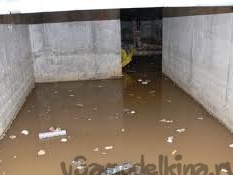
Groundwater problem and possible basement flooding - Two complex issues that should be addressed at the stage of construction of a country house. Ignoring these moments can lead to such undesirable consequences as the destruction of the foundation, its subsidence, flooding of the basement and damage to its entire contents, as well as the floors of the first floor. How should protective measures be taken to prevent disaster? If you still couldn’t avoid the problem, what should I do? The following information may be useful to you.
What leads to an increase in groundwater?
For example, it can be spills of closely located rivers or an increase in water level provoked by heavy rainfall. Can we influence the first factor? We personally like summer residents, unlikely. But we can provide for the quickest removal of precipitation.
How to drain groundwater?
So that groundwater in the basement of a country house does not create problems, they simply should not be there. To do this, it is worth performing protective measures. What can be attributed to them? Well, firstly, it’s a well-constructed drainage, and secondly, waterproofing.
Waterproofing is necessary from moisture contained in the soil in any case, and when groundwater flows significantly below the level of the basement floor, without affecting the underground part of the structure. It is possible to treat all concrete surfaces with special water-repellent compounds, to seal the seams “wall-wall”, “wall-floor”. This way we can be sealed ...
There is also injectable waterproofing. Its essence is that all cracks are filled with multicomponent materials. Due to its special properties, the substance injected under pressure with special equipment quickly fills all available external and internal voids, hardens, thereby reliably blocking access to water.
You can forget about the flooding of basements if, in addition to waterproofing, take care of the drainage system on the site.
Option 1.
With the help of a drill, we will make several wells with a minimum diameter of 10-15 cm, and a length of 3-5 meters on average. As a rule, such a length is enough to provide fluid access to the permeable layers through the dense clay, which retain water, causing it to accumulate. We lower a special pipe inside or fill it with gravel to the upper boundary of the hole, cover with a lid and fill it with earth.Wells, of course, it is worth doing in the low parts of the site and build supply paths to them along which flowing water will flow. As a result, water does not accumulate in the upper layers of the soil, for example, during rain or snowmelt, but freely and deeply passes through the water-resistant layers of the soil. Moreover, it is very fast! Such wells are recommended to be made around the entire perimeter of the basement and in its vicinity.
Option 2
You can also build a drainage system as follows. First of all, it is required to assess the nature of the slope in the summer cottage, which in turn will determine the degree of slope of the pipes. In addition, the larger the diameter of the pipe, the greater the slope. Thus, an independent flow of water is provided in the direction opposite to the site. We dig trenches along the perimeter of the house and one or two more in the direction from the house to drain the liquid. They should be about 1.5 meters deep, 0.4 meters wide, and the exit slope should be below the basement level. We cover the bottom with waterproofing tecton, then geotextile (the width of the material should be sufficient to wrap them with subsequent elements of the entire system). The next layers are crushed stone with a thickness of 5 cm and the pipe itself (under the necessary slope!). We fill the pipes with rubble, the layer of which should be approximately 40 cm, cover everything with geotextiles, pour sand and earth on top. For flat areas, an additional drainage well is dug, where rainwater will collect. From time to time they are pumped out using a pump.
If the basement is already flooded.
If the organization of waterproofing during construction was not discussed, and the basement was flooded, then it is urgent to drain it, and then think about the drainage system. A properly laid drainage network will collect and discharge not only groundwater, but also melt, rainwater, constantly protecting the foundation, basements from excessive moisture.
Drain the flooded room using a submersible pump of drainage or fecal type. There is nothing complicated in their design and operation, which does not prevent the devices from effectively solving their tasks. The choice of model entirely depends on the composition of the fluid in your area, the number and size of foreign particles in it. The drain pump will do fine with clean or heavily contaminated water. However, fecal pumps all the liquid if it is not just contaminated, but contains debris, for example, particles 50 mm in size.
The next point should be the organization of a drainage network in the area using one of the two above methods.
www.kak-sdelat.su
